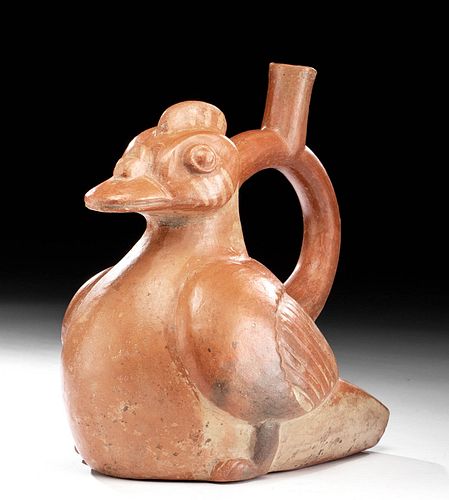Moche Pottery Muscovy Duck Stirrup Vessel
Lot 81a
About Seller
Artemis Fine Arts
686 S Taylor Ave, Ste 106
Louisville, CO 80027
United States
Selling antiquities, ancient and ethnographic art online since 1993, Artemis Gallery specializes in Classical Antiquities (Egyptian, Greek, Roman, Near Eastern), Asian, Pre-Columbian, African / Tribal / Oceanographic art. Our extensive inventory includes pottery, stone, metal, wood, glass and textil...Read more
Estimate:
$1,600 - $2,400
Absentee vs Live bid
Two ways to bid:
- Leave a max absentee bid and the platform will bid on your behalf up to your maximum bid during the live auction.
- Bid live during the auction and your bids will be submitted real-time to the auctioneer.
Bid Increments
| Price | Bid Increment |
|---|---|
| $0 | $25 |
| $300 | $50 |
| $1,000 | $100 |
| $2,000 | $250 |
| $5,000 | $500 |
| $10,000 | $1,000 |
| $20,000 | $2,500 |
| $50,000 | $5,000 |
| $100,000 | $10,000 |
| $200,000 | $20,000 |
About Auction
By Artemis Fine Arts
Oct 22, 2020
Set Reminder
2020-10-22 10:00:00
2020-10-22 10:00:00
America/New_York
Bidsquare
Bidsquare : Ancient & Ethnographic Art Through The Ages
https://www.bidsquare.com/auctions/artemis-gallery/ancient-ethnographic-art-through-the-ages-5850
Ancient art from Egypt, Greece, Italy and the Near East, as well as Asian, Fossils, Pre-Columbian, Native American, African / Tribal / Oceanic, Fine art, and much more! All categories, all price ranges... all legally acquired and guaranteed to be as described or your money back. Artemis Fine Arts info@artemisgallery.com
Ancient art from Egypt, Greece, Italy and the Near East, as well as Asian, Fossils, Pre-Columbian, Native American, African / Tribal / Oceanic, Fine art, and much more! All categories, all price ranges... all legally acquired and guaranteed to be as described or your money back. Artemis Fine Arts info@artemisgallery.com
- Lot Description
Pre-Columbian, Peru (North Coast), Moche III, ca. 300 CE. A mold-made bi-chrome ceramic vessel in the form of a seated Muscovy duck, its body fat, its head proudly forward above its chest. A stirrup handle with a short, slightly flared, cylindrical spout rises from the back of the duck's head and near its detailed tail feathers. The duck's wings cross low on its the back. The caruncle on the base of its upper bill is true to life for this distinctive species. Creamy white, red, and orange pigment give the duck a colorful striped body. The Moche domesticated the Muscovy duck and used it for feathers; feathers were a decorative symbol of royalty. The males of the species are frequently aggressive, and this drew the attention of the Moche, making the animal a special symbol for warriors. The Lord of Sipan was buried with ear spools decorated with Muscovy ducks, probably to emphasize his status as a powerful warrior. Size: 8.25" W x 8.75" H (21 cm x 22.2 cm)
See another example of a Moche Muscovy duck at the Houston Museum of Fine Arts (2010.1768).
Provenance: ex-private Hans Juergen Westermann collection, Germany, collected from the 1950s to the 1960s
All items legal to buy/sell under U.S. Statute covering cultural patrimony Code 2600, CHAPTER 14, and are guaranteed to be as described or your money back.
A Certificate of Authenticity will accompany all winning bids.
We ship worldwide and handle all shipping in-house for your convenience.
#101405Expertly repaired and restored. Some small areas of pigment loss and restoration with a few light deposits on surface. Great preservation of form and details.Condition
- Shipping Info
-
All shipping is handled in-house for your convenience. Your invoice from Artemis Gallery will include shipping calculation instructions. If in doubt, please inquire BEFORE bidding for estimated shipping costs for individual items.
-
- Buyer's Premium



 EUR
EUR CAD
CAD AUD
AUD GBP
GBP MXN
MXN HKD
HKD CNY
CNY MYR
MYR SEK
SEK SGD
SGD CHF
CHF THB
THB















